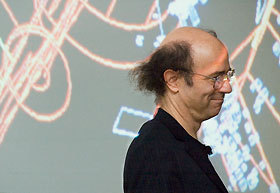  |
| HOME | THIS ISSUE | CALENDAR | GRANTS | BACK ISSUES | < BACK | NEXT > |
Physics Nobelist says universe composed largely of ‘dark stuff’by Cindy Weiss - September 26, 2005 |
||||
|
Frank Wilczek, a 2004 Nobel Prize co-winner in physics and one of the world’s leading theoretical physicists, delivered his view that “the universe is a strange place” during the Katzenstein Distinguished Lecture Sept. 16, part of the physics department’s Einstein Centennial Colloquium Series.
Wilczek, the Herman Feshbach Professor of Physics at MIT, won the Nobel Prize last fall, along with David Gross of the University of California at Santa Barbara and David Politzer of the California Institute of Technology, for discovering asymptotic freedom. This describes the paradox that quarks, the most basic building blocks of matter, smaller even than protons and neutrons, have a weak attraction when they are close to each other but become more strongly attracted to each other the farther away they are. “The work he did was very important in terms of what is called the Standard Model of physics,” said William Stwalley, Board of Trustees Distinguished Professor and head of the physics department. The Standard Model explains current thinking in high energy physics about elementary particles. You can’t see quarks, Wilczek pointed out, showing a slide demonstrating the movement patterns of a quark, an anti-quark, and a gluon. “I don’t know which is which,” he told a packed audience in the Physics 38 lecture hall. Gluons – particles that help hold quarks together – have zero mass, Wilczek noted, and quarks have a mass that is not quite zero but is much less than protons. “We have produced the feat of creating mass from no mass,” he said, one of the many paradoxes in contemporary physics theory. As the world celebrates the 100th anniversary of Einstein’s publishing three of his theories, including special relativity, Wilczek said that “right from the beginning, Einstein had in mind it would be a good thing to explain mass in terms of energy. “Because of the possibility of getting mass out of energy, it’s not odd that we have protons and neutrons out of essentially mass-less building blocks,” he said. Ninety-five percent of the universe is composed of “dark stuff that we don’t know much about,” Wilczek said: 25 percent is dark matter, which is actually invisible, and 70 percent is dark energy, which is also invisible. He called this “the strange universe emerging at unknown parts of physics.” “How do you think about it? How does it behave?” These will be the questions confronting physicists in the coming years, he said. “The most profound lesson of physics in the second half of the 20th century is what appears to be empty space is a dynamical medium.” The forces at work in seemingly empty space and new discoveries in particle physics will lead, in the next five to 10 years, to finding out whether the ideas now in play are the explanation of the dark matter, he said. “Our current concepts of physics will be tested in coming years,” Wilczek added. “You’ll have to learn different things, and in some ways, they’re more abstract, but we haven’t reached yet the limits of human understanding.” Wilczek’s theory of asymptotic freedom was cited by the Swedish Royal Academy of Sciences as having brought physics one step closer to a unified theory of the Universe, which eluded Einstein and would explain the entire physical world. Attending Friday’s lecture were several alumni who earned master’s degrees in physics at UConn in the mid 1950s, when the late Henry Katzenstein was a physics graduate student: David Lee, now a professor at Cornell University and the 1996 Nobel Prize winner in physics; John Reppy, who recently retired from the Cornell physics department; and Michael Zatzick, who later earned a Ph.D. at Brown University. Reppy earned his bachelor’s degree in 1954 in math and switched to physics for his master’s in 1956, after working with Katzenstein. Zatzick said that he, Katzenstein, and former faculty member Stephen Friedland built Polaroid Corp.’s first mass spectrometer. Katzenstein earned the first Ph.D. in physics at UConn in 1954. During his career, his work led to a patent for reading information from compact discs, and he co-founded the Brooktree Corp., a California semiconductor company. In 1996, he established an endowment that funds the annual lecture and a prize in his name. Lee was the first Katzenstein lecturer in 1997. |
| ADVANCE HOME UCONN HOME |

